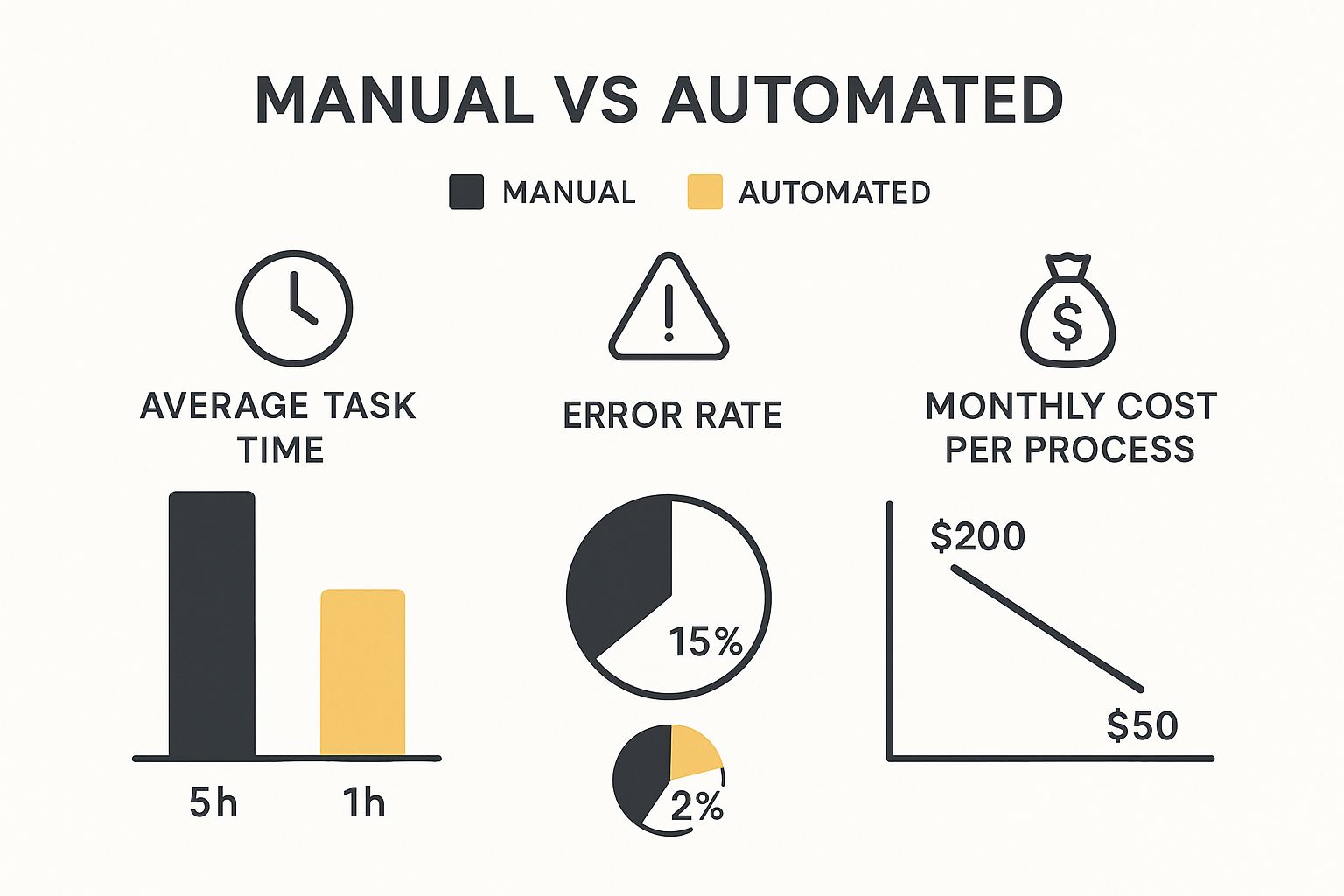Trying to scale a business without laying the groundwork first is like building a house on a shaky foundation. The thrill of new customers and bigger orders can quickly sour into a mess of missed deadlines, unhappy clients, and a completely fried team if your internal systems aren't ready for the pressure.
Before you pour money into a huge marketing campaign or start dreaming of new locations, you need to take a hard, honest look at your business's health.
Building Your Foundation for Scalable Growth

This is about more than just checking your bank balance. It’s about knowing your real capacity. Can your current team actually handle double the work? Are your suppliers solid enough to manage a sudden spike in demand? True readiness for growth means having predictable cash flow and systems that don’t completely rely on you, the owner, being there 24/7.
Assess Your Business Health Realistically
First things first: you need to do a thorough audit of your core business pillars. Gut feelings won’t cut it here; you need to look at the cold, hard data to see where you really stand. The goal is to find the potential breaking points before they snap under the weight of expansion.
Start by digging into these key areas:
- Financial Stability: Do you have at least three to six months of operating expenses stashed away? Is your revenue steady, or are you constantly on a cash flow roller coaster?
- Operational Capacity: Map out your entire process, from the moment a lead comes in to when an order is fulfilled. Where are the bottlenecks? If 50 new orders landed in your inbox tomorrow, which part of the chain would break first?
- Team Readiness: Take a realistic look at your team's skills and workload. Are they already stretched to their limits, or is there room for them to take on more? Pinpoint any skill gaps you’ll need to fill, either by hiring or training.
This audit is your roadmap for what to fix before you add more complexity. A huge part of this is getting comfortable with the new systems and tools that growth demands, which is really about embracing a digital transformation for small business.
Before you scale, it's critical to know if your business is truly ready. This simple checklist can help you quickly gauge where you stand and what needs your immediate attention.
Growth Readiness Checklist
| Area of Business | Key Readiness Indicator | Action Item |
|---|---|---|
| Finance | At least 3-6 months of operating expenses in reserve. | Build up cash reserves; review and cut unnecessary costs. |
| Operations | Clear, documented processes for core tasks. | Create a "playbook" for key workflows (sales, fulfillment, etc.). |
| Team | Team members are not consistently overworked. | Assess workloads and identify tasks that can be automated or delegated. |
| Technology | Systems can handle a 2x increase in data/traffic. | Evaluate current software; plan for upgrades to CRM, ERP, etc. |
| Marketing | A proven, repeatable customer acquisition channel. | Double down on what's working; document the process for new hires. |
Taking the time to check these boxes isn't about slowing down; it's about making sure you can speed up without crashing.
Refine Your Business Model for Scalability
Let's be honest—not all business models are built to scale. If you're a freelance consultant trading hours for dollars, you can only grow by working more or charging more. Both have a ceiling. A truly scalable model, on the other hand, lets you boost revenue without a matching increase in resources.
Think about a graphic designer who does one-on-one projects. To scale, they could create a line of pre-made design templates or launch an online course teaching design fundamentals. These products can be sold to thousands of people with very little extra effort for each sale.
Your goal here is to shift from a model that depends on you doing everything to one that relies on systems that do the work. This means productizing your services, automating repetitive tasks, and creating processes that anyone on your team can easily follow.
Document Everything to Create Your Playbook
If all the crucial knowledge about your business lives inside your head, you don’t really have a business—you have a very demanding job. The final piece of the foundation is documenting everything. This means creating a detailed playbook that outlines every important process in your company.
This isn't just for onboarding new hires; it's a vital tool for ensuring consistency and efficiency as you grow. Knowing the market potential can be a huge motivator here. As of 2023, the global small business market was valued at a massive USD 2.572 trillion and is expected to nearly double to USD 4.985 trillion by 2032.
That explosive growth represents a huge opportunity for businesses that are actually prepared to seize it. Your playbook is the key that unlocks that potential for your own company.
Creating a Scalable Marketing Engine

If you really want to scale, you have to get your brand in front of more of the right people, consistently. A marketing plan that leans on manual, one-off efforts is a recipe for a bottleneck. You need to build a marketing engine—a system that grows with you, not against you.
This is about moving past sporadic social media posts and building repeatable, measurable processes that bring in leads around the clock. The idea is to create a predictable flow of new customers without your workload or budget having to balloon proportionally. It's about working smarter to fuel your growth.
Move Beyond Random Acts of Marketing
So many small businesses fall into the "random acts of marketing" trap. A Facebook post here, an email blast there, with nothing tying it all together. To scale, you have to ditch that chaotic approach and build a structured, automated lead generation funnel.
A funnel is just the path a potential customer takes from first hearing about you to actually buying something. A scalable funnel automates a huge chunk of that journey. For example, a visitor downloads a free guide from your website (top of the funnel), which then kicks off an automated email sequence to nurture their interest (middle), and eventually serves up a compelling offer (bottom).
The real magic of a marketing funnel is that it works for you 24/7. Once it’s running, it qualifies and educates leads on its own, meaning you spend your precious time talking to prospects who are actually ready to buy.
This system turns marketing from a time-suck into a predictable, asset-building machine. It's a non-negotiable step for any business owner serious about growth.
Leverage Content to Build Authority and Trust
Paid ads are great for a quick hit, but it's like renting an apartment—the second you stop paying, your presence vanishes. Content marketing, on the other hand, is like building a house. It's an asset that gains value over time, pulling in organic traffic long after you hit "publish."
Good content builds authority by proving you know your stuff and answering your audience's biggest questions. That creates trust, which is the secret ingredient for turning browsers into buyers. A smart content plan can seriously cut your long-term dependency on expensive ads.
Here’s how to build a content strategy that scales:
- Pillar Content: Create a few massive, comprehensive guides on the core topics in your industry. Think of these "pillar" pieces as the central hub for a specific subject.
- Cluster Content: Develop smaller, related pieces of content—blog posts, short videos, social media updates—that all link back to your main pillar page. This structure tells search engines you're an authority on that topic.
- Repurpose Everything: Don't just create content; multiply it. A single pillar article can be sliced and diced into an infographic, a video script, a dozen social media posts, and an email newsletter. You maximize your output without constantly reinventing the wheel.
By creating stuff people actually find valuable, you attract a qualified audience and build a sustainable source of leads that grows on its own.
Implement a CRM to Nurture Leads at Scale
As you start getting more leads, trying to manage them in a spreadsheet or your inbox becomes a complete nightmare. A Customer Relationship Management (CRM) system is non-negotiable if you want to scale. It’s your central command center for every customer interaction, letting you personalize your communication without going insane.
With a CRM, you can segment your audience based on their behavior and interests, then send them targeted messages that actually resonate. For instance, you can automatically tag a lead who downloaded a specific ebook and send them follow-up content on that exact topic. With 51% of global consumers recently discovering a new brand on social media, you can’t afford to let those leads slip through the cracks.
A well-oiled CRM lets you:
- Track every interaction: Know exactly where each lead is in your sales process, instantly.
- Automate follow-ups: Set up reminders and email sequences so no one gets forgotten.
- Personalize communication: Use the data you have to tailor your messaging, making customers feel like you actually get them.
This level of organization is what separates businesses that successfully scale from those that stall out. Making smart choices here is everything, and you can dig deeper into data-driven marketing strategies to see how. Building this engine ensures your marketing efforts compound, delivering predictable growth and a serious competitive advantage.
Optimizing Operations with Smart Automation
When your marketing engine finally kicks into high gear, the new customers start rolling in. It's an amazing feeling, but it also puts a ton of pressure on your internal operations. Growth has a funny way of exposing every single crack in your manual processes, turning those tiny inefficiencies into massive bottlenecks.
To scale without everything catching fire, you need to build an operational machine. One that can handle a bigger workload without dropping the ball on quality or completely burning out your team.
This is where smart automation comes in. It’s not about replacing your people. It’s about freeing them from the mind-numbing, repetitive tasks so they can focus on what actually moves the needle—strategy, building customer relationships, and innovating. By automating the right things, you build a leaner, tougher business that’s ready for whatever comes next.
Pinpoint Your Biggest Operational Bottlenecks
Before you can fix the clog, you have to find it. Start by mapping out your most critical workflows from beginning to end. Where do things grind to a halt? Where do mistakes seem to pop up over and over again? These are your prime candidates for automation.
For most growing businesses, the pain points are pretty common:
- Customer Onboarding: Are you still manually sending welcome emails, setting up new accounts, and scheduling kick-off calls? That gets old, fast.
- Order Fulfillment: If your team is copying and pasting shipping details or manually updating inventory spreadsheets, you're not just wasting time—you're begging for errors.
- Financial Admin: Creating invoices, chasing down late payments, and processing expenses. These are the necessary evils that are absolutely perfect for a robot to handle.
- Project Management: Do tasks fall through the cracks because no one's assigning or tracking them properly? Manual project updates are a huge time-suck.
Once you’ve identified your top one or two bottlenecks, you can start hunting for the right tools to solve them. Don't try to automate everything at once. Focus on the areas that will give you the biggest immediate return in time saved and headaches avoided.
Implement Automation for Repetitive Tasks
The real goal here is to create simple, repeatable workflows that just run in the background. Tools like Zapier, Make, or IFTTT act like translators between the different apps you already use, letting them talk to each other without you playing middleman.
For example, you could set up a single automation that triggers every time a customer pays an invoice in Stripe. Instantly, their info is added to your Mailchimp list, a new project folder is created for them in Asana, and a personalized welcome email shoots out from your Gmail. That one "zap" could easily save your team hours every single week.
The infographic below really drives home how dramatic the shift from manual to automated workflows can be.

As you can see, automation doesn't just make things faster. It makes them significantly more accurate and cheaper to run, which is the secret sauce for scaling sustainably.
Embrace AI for Enhanced Productivity
Beyond just automating simple tasks, artificial intelligence (AI) is giving small businesses some serious new firepower. Adopting the right tech is what separates the businesses that scale gracefully from those that crumble under the pressure, and AI is at the front of that pack.
It's not just hype. About 75% of SMBs have started using or experimenting with AI. And the results? A staggering 91% of them report a positive impact on their revenue. Even better, 87% of SMBs using AI say it has directly helped them scale their operations.
AI isn't some futuristic concept anymore; it's a practical tool that small businesses are using right now to level the playing field. It helps you do more with less, which is the very essence of scaling.
Here are a few dead-simple ways you can start integrating AI into your business today:
- Customer Support: AI-powered chatbots can handle the common customer questions 24/7. Think "Where's my order?" or "What are your hours?" This frees up your human support team to deal with the complex issues that actually require a brain.
- Content Creation: Tools like Jasper or Copy.ai can be a lifesaver. Use them to brainstorm ideas, draft blog posts, knock out social media captions, or write email campaigns in a fraction of the time it would normally take.
- Data Analysis: You don't need a dedicated data scientist anymore. AI can chew through your sales data to spot trends, forecast demand, and give you insights to make smarter decisions.
When you build an operational foundation on both automation and AI, you create a business that isn't just growing, but growing smarter. You’re building a system that can absorb more demand without breaking a sweat. If you're looking for a place to start, exploring different approaches to AI and automation for businesses can provide a clear roadmap.
Securing the Right Funding for Your Growth
Growth almost always requires capital. Expanding your team, investing in new technology, and scaling your marketing all have a price tag. Let's be honest—managing that money correctly is often what separates a thriving business from a cautionary tale.
This isn't about simply finding a big check; it's about securing the right kind of funding at the right time. Taking the wrong deal or partnering with the wrong people can sink a promising business faster than a lack of sales.
Get Your Financial Projections Dialed In
Before you even think about asking for money, you need a crystal-clear picture of where your finances are headed. Gut feelings don't work here. You need solid, data-backed financial projections that prove you understand the economics of your business inside and out.
This means looking beyond your current revenue and creating detailed forecasts for the next 12, 24, and 36 months.
- Sales Forecast: Project future revenue based on historical data, market trends, and your planned marketing activities. Be realistic, not just optimistic. Investors can spot a "hockey stick" projection from a mile away.
- Expense Budget: Detail every single cost, from salaries and software subscriptions to inventory and office rent. Don't forget to account for inflation and have a line item for the unexpected—because it always happens.
- Cash Flow Statement: This is the most critical document of the three. It maps out the actual movement of cash in and out of your business, showing when you'll have surpluses and, more importantly, when you might face a shortfall.
These projections aren't just for investors; they are your strategic roadmap. They help you anticipate future capital needs, make smarter spending decisions, and prove that your growth plan is built on a solid financial foundation.
Explore All Your Funding Options
When founders think of funding, their minds often jump straight to traditional bank loans or high-stakes venture capital. But the funding landscape is way more diverse now, with options suited for different business models and growth stages. Knowing what's out there is key to finding the perfect fit.
Financial challenges are a major hurdle for scaling businesses. In fact, approximately 50% of small businesses fail within the first five years, and a stunning 38% of those failures are due to cash flow problems or an inability to raise capital. Understanding your funding options is a direct way to combat this statistic. You can find more insights on small business challenges at USChamber.com.
To help you navigate this, here's a quick comparison of some common funding sources.
Funding Options for Small Business Growth
Choosing how to fund your growth is one of the most important decisions you'll make as a founder. Each path comes with its own set of expectations, benefits, and trade-offs. The table below breaks down some of the most common options to help you figure out which one aligns with your business goals and vision.
| Funding Type | Best For | Key Consideration |
|---|---|---|
| Angel Investors | Early-stage startups needing seed capital and mentorship. | You'll be giving up equity and a degree of control. |
| Venture Capital | High-growth businesses with massive market potential. | VCs expect aggressive growth and a clear exit strategy. |
| Revenue-Based Financing | SaaS or subscription businesses with predictable revenue. | Repayments are a percentage of monthly revenue; no equity dilution. |
| Crowdfunding | Consumer product businesses with a strong community. | Requires significant marketing effort to succeed. |
Ultimately, the right path depends entirely on your goals. Are you willing to trade equity for a shot at rapid, explosive growth, or do you want to retain full ownership and grow at a steadier, more controlled pace? There is no single right answer, only the right answer for your business.
The most important part of fundraising is your story. Investors don't just invest in a spreadsheet; they invest in a compelling vision backed by a credible plan. Your ability to communicate that vision clearly is paramount.
Master Your Pitch and Manage Your Cash
Once you’ve identified the right funding type, you have to convince investors to back you. This usually comes down to a well-crafted pitch that tells a compelling story about your business and its potential. To really nail this, learning how to make a pitch deck that wins funding is a critical skill for any founder.
But getting the money in the bank is just the starting line. The real test is managing that capital effectively as you hit the gas.
Cash flow becomes even more critical when you're scaling. Your expenses—for new hires, bigger marketing budgets, and more inventory—often ramp up before the new revenue starts rolling in. You have to be disciplined.
Here are a few practices that will keep your finances healthy:
- Get on Robust Accounting Software: Move beyond basic spreadsheets. Tools like QuickBooks or Xero provide real-time insights into your financial health and automate tedious tasks, freeing you up to focus on strategy.
- Track Key Financial KPIs: Get obsessed with your numbers. Monitor metrics like Customer Acquisition Cost (CAC), Lifetime Value (LTV), and your monthly burn rate. These numbers tell you if your growth is actually profitable and sustainable.
- Maintain a Cash Reserve: I can't stress this enough. Always keep a buffer for unexpected opportunities or downturns. A healthy cash reserve gives you the flexibility to navigate challenges without derailing your entire growth plan.
Securing and managing funding is all about fueling your vision responsibly. It’s the lifeblood that allows you to turn a small, promising business into a scalable, sustainable enterprise that lasts.
Building a Team That Scales with You

Let's get one thing straight: you can't scale a business by yourself. You can optimize operations and build a killer marketing engine, but at the end of the day, your people are the ones who will truly drive sustainable growth.
The biggest mental shift for any founder is moving from a "founder-led hustle" to a team-driven organization. This is where things get real. It’s about more than just hiring people to fill seats—it's about strategically building a team that can grow with the company, take real ownership, and thrive when things get chaotic.
Hire for Your Future, Not Just Your Present
When you're completely swamped, the first instinct is to hire someone—anyone—to put out the immediate fires. This is reactive hiring, and while it feels good for a week, it often creates much bigger problems down the road.
To scale properly, you need to hire for the roles that will unlock the next level of growth, not just the tasks bogging you down today.
Look at your business goals for the next 12-18 months. What specific skills will get you there? Instead of hiring another generalist who can "do a bit of everything," maybe it’s time for your first dedicated salesperson. Or perhaps a customer success manager who can build processes to keep the clients you already have. These are strategic investments in your future capacity.
Cultivate a Culture That Competes with Perks
As a small business, you probably can’t throw money around like the big corporations. The good news? You don't have to. You can absolutely win the talent war by creating a company culture that offers things a fat paycheck can't buy.
Focus on these three pillars:
- Ownership and Impact: Give your team members real responsibility. Make it painfully obvious how their work directly contributes to the company's success. People are desperate for purpose, not just a paycheck.
- Flexibility and Trust: Offer flexible work arrangements and treat your team like the adults they are. A culture built on trust is a massive competitive advantage that rigid, bureaucratic companies can't replicate.
- Growth and Development: Invest in your team's skills. This doesn't have to be a massive budget—it can be access to online courses, mentorship opportunities, or just creating clear (even if informal) career paths. Show them they have a future with you.
A strong culture acts like a magnet for the right kind of people: ambitious, self-motivated individuals who are genuinely excited to build something alongside you.
Master the Art of Delegation and Empowerment
This is the hardest transition for most founders. Letting go. If you remain the bottleneck for every single decision, your business will never scale beyond your personal capacity. It just can't.
And let's be clear, real delegation isn't just dumping tasks on someone's plate. It's about empowering your team to make decisions and own the outcomes.
Delegation without empowerment is just micromanagement with extra steps. To truly scale, you have to build systems that let you trust your team with critical responsibilities, giving them the authority to act without needing your approval for every little thing.
This starts with creating clear documentation and standard operating procedures (SOPs) for your key processes. When the team has a playbook, they have the confidence to act on their own. This frees you up to focus on the high-level, strategic work that only you, as the founder, can do. As you grow, understanding how to build high-performing teams becomes less of a soft skill and more of a survival tactic.
Building this kind of team isn't a one-and-done task; it’s a deliberate, ongoing process. It requires you to shift your mindset from being the star player to being the coach. Invest in your people, foster a culture of ownership, and build the systems that help them win. That’s how you create a business that can finally grow beyond you.
Common Questions About Scaling a Business
Embarking on a growth journey always brings up a ton of questions. Let's be honest, figuring out how to scale a small business often means anticipating the tough questions before they turn into full-blown crises. We'll tackle some of the most common uncertainties founders run into.
Having the right answers gives you clarity and confidence, turning potential roadblocks into manageable steps on your path to sustainable growth.
When Is the Right Time to Start Scaling?
The perfect moment to scale isn't just when demand is high—it's when your internal systems are proven and resilient. True readiness shows up as consistent profitability and a predictable way of generating new leads.
You also need high customer retention rates. This proves your product or service is actually delivering value over and over again. Most importantly, your core operational processes have to be documented so clearly that someone else can step in and run them successfully.
If the business still depends entirely on you for every critical function, you're not ready to scale. Growth should happen when your foundation is strong enough to handle more weight, not before.
What Is the Biggest Mistake Small Businesses Make?
The most common—and damaging—mistake is trying to scale too quickly. Business owners get excited and chase growth without the cash flow or operational infrastructure to back it up. We've seen it happen: they eagerly accept huge orders or sign new clients before they have the team, systems, or capital to deliver.
This "growth at all costs" mindset almost always leads to team burnout, a sharp decline in quality, and serious damage to the brand's reputation. More often than not, it's a fast track to business failure.
Remember, profitable and sustainable scaling is a marathon, not a sprint. A rushed expansion usually creates more problems than it solves.
How Can I Scale Without a Large Budget?
Scaling your business doesn't have to mean securing a massive investment for expensive technology. The key is to start with low-cost, high-impact tools that solve a specific, painful problem.
Many powerful software solutions offer free or highly affordable entry-level plans.
- Customer Relationship Management (CRMs): Tools like HubSpot or Zoho can help you organize and track your sales pipeline, often starting for free.
- Project management tools: Platforms like Trello or Asana bring clarity and accountability to your team's workflow.
- Social media schedulers: A tool like Buffer can save you hours of manual posting each week.
Focus on automating one key bottleneck at a time. The goal is to invest in technology that provides a clear and immediate return, either by saving time or boosting sales. This approach allows your tech stack to become a self-funding endeavor over time, paying for itself as you grow.
At Up North Media, we specialize in building the digital foundation your business needs to scale effectively. From custom web app development to data-driven SEO, we create solutions that support your growth at every stage. Schedule your free consultation today and let's build your future, together.
